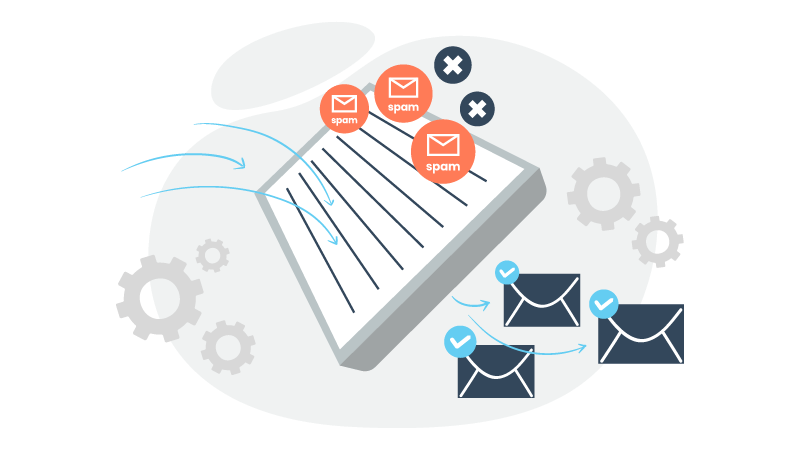电子邮件被视为垃圾邮件?最佳电子邮件发送工具
有效的电子邮件营销是任何企业成功的一个重要方面。然而,一个经常困扰营销人员的重大挑战就是可怕的垃圾邮件文件夹。
当您精心制作的电子邮件最终出现在那里时,您就会错失潜在的客户和机会。幸运的是,这些工具可以帮助您提高电子邮件的可送达性并接触到客户。

为什么电子邮件会成为垃圾邮件?
每个电子邮件营销人员最可怕的噩梦就是臭名昭著的垃圾邮件文件夹。这是一个数字深渊,精心制作的电子邮件就在这里消亡。但是,为什么会发生这种情况呢?电子邮件被扔进垃圾邮件文件夹的原因又是什么呢?
-
53.49%的电子邮件被归类为垃圾邮件。
-
平均电子邮件送达率约为80%。这意味着每发送100封电子邮件,只有大约80封能到达收件人的收件箱。
-
电子邮件被拦截的前三大原因是:
-
垃圾邮件过滤器(40%)
-
无效的电子邮件地址(19%)
-
内容违规(18%)
-
1.糟糕的发送方式
电子邮件可送达性问题的主要原因之一是发送方式不当。如果您快速发送大量邮件,或没有正确划分您的邮件列表,互联网服务提供商(ISP)可能会将您的邮件标记为垃圾邮件。
2.参与度低
互联网服务提供商会监控收件人如何参与您的电子邮件。如果您的邮件总是无人打开或未经阅读就被删除,这就表明您的邮件无关紧要,更有可能被当作垃圾邮件过滤掉。
3.订阅者名单不准确
向过时的或购买的电子邮件列表发送邮件,而这些列表中充斥着不活跃或未经验证的地址,这无疑会让邮件落入垃圾邮件文件夹。互联网服务提供商更青睐拥有干净、选择加入列表的发件人。
4.过度使用垃圾关键字
在主题行或内容中使用 "免费"、"保证 "或 "紧急 "等触发词会绊倒垃圾邮件过滤器。关键是要保持平衡,避免过度宣传。
5.缺乏认证
SPF、DKIM 和 DMARC 等电子邮件验证协议对于验证您作为合法发件人的身份至关重要。如果没有这些协议,您的电子邮件可能会受到怀疑。
6.黑名单
如果您的 IP 地址或域名因从事垃圾邮件活动而被列入电子邮件黑名单,互联网服务提供商就会轻易地将您的电子邮件导入垃圾邮件文件夹。
7.隐藏的退订链接
隐藏退订链接或让收件人难以找到退订链接违反了电子邮件法规,并可能导致您的电子邮件被标记为垃圾邮件。如果退订太难,收件人甚至会手动将您的电子邮件标记为垃圾邮件。
8.未优化的 HTML 和编码
格式不佳的电子邮件或编码错误会触发垃圾邮件过滤器。请确保您的电子邮件设计合理,并对移动设备友好。
9.附件和链接注意事项
发送带有大型附件或恶意网站链接的电子邮件会增加被标记为垃圾邮件的几率。
电子邮件可送达性工具的作用
在追求纯净的电子邮件可送达性的过程中,营销人员有一个强大的盟友,那就是电子邮件可送达性工具。这些工具可确保您的电子邮件穿越垃圾邮件过滤器的重重险阻,到达目标收件人的收件箱。让我们来探讨一下它们在电子邮件营销中的作用和意义。
-
增强收件箱位置:电子邮件送达工具的主要任务是优化您的电子邮件营销活动,以便更好地投放到收件箱中。它们的作用是确保您的电子邮件被投递到正确的位置,而不是在垃圾邮件文件夹中徘徊。这反过来又能提高目标受众的可见度,从而促进您的电子邮件营销取得成功。
-
垃圾邮件检测和预防: 可送达性工具拥有先进的算法和数据库,可识别和减少潜在的垃圾邮件触发因素。它们会扫描电子邮件中的垃圾内容、链接或附件,并帮助您在点击 "发送 "之前进行必要的调整。
-
列表管理和细分: 有效的邮件发送工具通常包括列表管理和细分功能。它们可以帮助您维护干净、细分的电子邮件列表,这对于确保您的邮件发送给参与和感兴趣的受众至关重要。
-
验证协议:许多电子邮件发送工具都能帮助实施基本的电子邮件验证协议,如 SPF(发件人策略框架)、DKIM(域键识别邮件)和 DMARC(基于域的邮件验证、报告和一致性)。这些协议可提高电子邮件在互联网服务提供商眼中的合法性。
-
报告和分析: 这些工具通过报告和分析提供有价值的见解。它们会跟踪打开率、点击率、跳出率和转换率等关键指标。这些数据能让你做出以数据为导向的决策,并微调你的电子邮件营销策略。
-
A/B 测试: 电子邮件送达工具通常具有A/B 测试功能,可让您尝试不同的主题行、内容和发送时间。这一功能可帮助您优化营销活动,提高参与度,从而提高送达率。
-
警报和通知:有些工具提供实时警报和通知,以告知您任何送达问题。这种积极主动的方法可以让您在邮件发送遇到困难时迅速采取行动。
-
适应性和可扩展性: 最好的电子邮件送达工具具有适应性和可扩展性。它们可以随着您的业务需求而发展,无缝地适应您的电子邮件营销工作的增长。
热门电子邮件送达工具
对于电子邮件营销人员来说,电子邮件的可送达性是一个至关重要的问题,而要实现较高的收件箱投放率则极具挑战性。幸运的是,有几种流行的电子邮件送达工具可以应对这些挑战。
1.HubSpot
HubSpot 提供电子邮件营销工具,可帮助进行电子邮件内容优化、个性化和 A/B 测试。这可确保您的电子邮件引人入胜,与受众息息相关。该平台提供详细的分析和报告功能,以跟踪电子邮件性能、发现问题并进行数据驱动的改进。
HubSpot 允许您根据各种标准对电子邮件列表进行细分,帮助您向特定受众群体发送定制信息。它提供营销自动化功能,可简化电子邮件营销流程,让您及时发送个性化信息。此外,HubSpot 还能与其他营销和 CRM 工具无缝集成,使管理联系人和跟踪客户互动变得简单。
HubSpot 的优势:
-
一体化解决方案:HubSpot 是一个一体化的入站营销平台,通过集中各种营销工作简化了电子邮件营销管理。
-
用户友好: HubSpot 以用户友好的界面和易用性著称,初学者和有经验的营销人员都可以使用。
-
强大的分析功能: HubSpot 提供强大的分析功能,帮助您有效衡量和改进电子邮件绩效。
-
自动化: 自动化功能可节省时间,与受众进行更个性化的沟通。
-
分层定价:HubSpot 提供分级定价计划,使不同规模和预算的企业都能使用。无论是小型初创企业还是大型企业,您都能找到适合自己需求和资源的计划。
-
HubSpot 学院:HubSpot 通过HubSpot Academy 提供丰富的教育资源。其中包括电子邮件营销和入站策略 方面的课程、认证和资源,帮助用户提高电子邮件营销技能和知识。
应用于电子邮件送达
HubSpot 的电子邮件优化和列表细分功能有助于确保电子邮件具有针对性和相关性,减少落入垃圾邮件文件夹的几率。它的分析和报告工具还能让你监控电子邮件的送达性、跟踪打开率,并调整策略以最大限度地提高收件箱中的位置。
2.发送网格
SendGrid 提供强大的电子邮件发送服务,包括电子邮件发送、监控和分析。它提供 API,可无缝集成到您现有的应用程序和平台中。此外,SendGrid 还可进行列表管理和细分,帮助您发送有针对性的电子邮件。
您可以执行 A/B 测试来优化电子邮件内容并提高送达率。此外,SendGrid 还支持 DKIM 和 DMARC 等电子邮件验证协议,以提高发件人信誉。
SendGrid 的优势:
-
可扩展性:SendGrid 适合各种规模的企业,从初创公司到大型企业。
-
可靠的送达: 该平台以高电子邮件送达率著称,可确保您的电子邮件送达预定收件人。
-
深入分析: 该平台提供详细的分析,让您能够评估电子邮件营销活动的效果。
-
集成: SendGrid 与各种应用程序无缝集成,可满足不同的业务需求。
应用于电子邮件送达
SendGrid 的电子邮件发送服务和合规性功能可确保电子邮件的可靠发送和发件人身份验证,降低被标记为垃圾邮件的可能性,从而提高电子邮件的可送达性。
3.邮件枪
Mailgun 提供可靠的电子邮件发送服务,注重高送达率。它提供电子邮件验证工具,确保您的电子邮件列表准确、及时。您可以执行 A/B 测试来优化电子邮件内容并提高参与度。
Mailgun 的分析工具可帮助您跟踪电子邮件性能并相应调整策略。该平台可与各种应用程序和服务集成,提供无缝的电子邮件营销体验。
Mailgun 的优势:
-
可送达性: Mailgun 的首要关注点是送达性,这使其成为优先考虑收件箱位置的企业的有力选择。
-
电子邮件验证: 邮件验证功能有助于保持邮件列表的整洁和参与性,进一步提高送达率。
-
开发人员友好:Mailgun 对开发人员友好,适合拥有技术团队的企业使用。
应用于电子邮件送达
Mailgun 非常注重可送达性、电子邮件验证和 A/B 测试功能,确保将电子邮件发送给参与的收件人,并对内容进行优化,以最大限度地在收件箱中投放,从而提高电子邮件的可送达性。
4.SendinBlue
SendinBlue 提供创建和发送电子邮件活动的工具。它提供营销自动化功能,可及时发送有针对性的信息。通过该平台,您可以细分电子邮件列表并有效管理联系人。
SendinBlue 包括 A/B 测试功能,可优化电子邮件内容,并提供分析和报告功能以跟踪电子邮件性能。
SendinBlue 的优势
-
经济实惠:SendinBlue 以其极具竞争力的价格而著称,是企业的高性价比之选。
-
用户友好: 该平台用户友好,界面简单明了,适合各种水平的用户使用。
-
自动化: 自动化功能可简化电子邮件营销流程,提高参与度。
应用于电子邮件送达
SendinBlue 提供易于使用的电子邮件营销工具,可通过列表细分和 A/B 测试提高电子邮件的送达率。虽然它对送达率的关注程度可能不及其他一些平台,但它为希望改进电子邮件营销工作的企业提供了一种经济高效的解决方案。
这些流行的电子邮件送达工具都具有独特的功能、优势和局限性。最适合您企业的工具取决于您的具体需求、预算和技术要求。通过选择合适的工具并有效利用其功能,您可以大大增加电子邮件到达梦寐以求的目的地:收件人收件箱的机会。
利用可送达性工具实现电子邮件营销的成功
在电子邮件营销的世界里,从制作引人注目的信息到确保它们安全到达收件人的收件箱,这一路上障碍重重。但是,利用电子邮件可送达性工具的强大功能,您就可以充满信心地完成这一过程。
通过遵循电子邮件营销最佳实践并利用这些电子邮件送达工具的功能,您就能确保您的电子邮件始终如一地进入收件人的收件箱,从而将您的电子邮件营销成功推向新的高度。
此内容还可以翻译:
- 德文: E-Mails landen im Spam? Die besten E-Mail-Zustellbarkeits-Tools
- 英文: Email Ending Up in Spam? The Best Email Deliverability Tools
- 西班牙文: ¿Emails en spam? ¡Mejora entrega con estas herramientas!
- 意大利语: Email spam? Strumenti consegna
- 法文: Emails dans les spams ? Outils de délivrabilité








发表评论